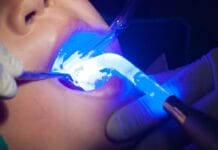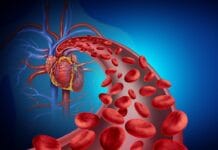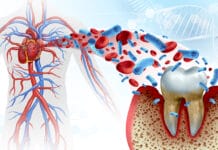It’s estimated that around 4% of American adults over age 65 have been diagnosed with dementia.1 Studies in the past have indicated that poor oral health and cognitive decline have an association. One such study found that tooth retention decreased the risk of atrophy in certain areas of the brain, while the severity of periodontitis was associated with increased atrophy in brain regions that are associated with Alzheimer’s disease.2
Finding an association is just a stepping stone, as correlation does not equal causation. However, finding a relationship between two diseases prompts more research to identify causality. Causality is a relationship in which one event causes another. It is the cause-and-effect model. For instance, evidence shows smoking (cause) causes lung cancer (effect).3
Recently published studies give more insight into the association between oral health and cognitive decline. Before diving into these studies, I need to explain the type of studies I will be citing for this article.
The three main studies that I will use to infer if there is a causal relationship between dental caries, periodontal disease, occlusal dysfunction, and brain health are Mendelian randomization analyses. Since this type of study is not well known, an explanation is warranted to highlight the methodology and how it can infer causality.
Succinctly, Mendelian randomization uses genetic variants to investigate causal relationships between potentially modifiable risk factors and health outcomes from observational data.4 The critical thing about Mendelian randomization is that, in general, it infers causality.4,5
The University of Bristol has a great two-minute video on Mendelian randomization that you can watch here for a better understanding.5
Dental Caries
Dental caries continues to be a public health concern despite being a preventable disease.6 According to national surveys, almost 90% of adults ages 20 to 64 have had dental decay. Adults aged 50 to 64 have the highest rate, with 96% prevalence in national surveys.7
The incidence and prevalence of dental caries are often measured using the DMFT (decayed, missing, and filled teeth) index or DMFS (decayed, missing, and filled tooth surfaces) index.8,9
A recently published Mendelian randomization analysis utilized the DMFS index to investigate a potential causal relationship between dental caries and brain alterations. The study found that dental caries causally decreased the thickness of the banks of the superior temporal sulcus (BANKSSTS).9
Since we are dental experts and not brain experts, it is essential to understand what the BANKSSTS is and what decreased thickness in this brain area means.
BANKSSTS is the brain region where written and spoken language processing converges. Therefore, decreased thickness in the BANKSSTS could cause a decline in reading and language-related functions. Reading comprehension may decline, and communication could be impacted as well. But most importantly, this region of the brain is the most impaired cortical region in patients with Alzheimer’s disease.9
It is hypothesized that the accumulation of beta-amyloid protein plays a role in the initial pathology of Alzheimer’s disease. Patients with Alzheimer’s disease with higher beta-amyloid accumulation in the BANKSSTS exhibit faster rates of decline in memory and executive function. Additionally, the BANKSSTS region is one of the first regions that showed cortical atrophy and glucose hypometabolism in the early stages of Alzheimer’s disease.9
Though this study suggests a causal impact of dental caries on brain alterations, further functional studies are required to determine how much of a role, if any, the reduced thickness of the BANKSSTS due to dental caries plays in Alzheimer’s disease and other types of dementia.9
Periodontal Disease
Many large-scale epidemiological studies have indicated an association between periodontal disease and Alzheimer’s disease. Some studies imply that patients with Alzheimer’s disease have an impaired ability to maintain proper oral hygiene due to cognitive decline, which leads to an increased risk of developing periodontal disease. While others postulate that periodontal disease contributes to Alzheimer’s disease onset and progression.10
Finding causality could answer the question regarding which disease initiates the other, or is it simply a temporal association? A temporal association means one thing follows another.3 In the case of periodontal disease and Alzheimer’s disease, previous studies are unclear on whether one precedes the other, if there is a causal factor, or if they occur concurrently.10
A Mendelian randomization analysis aimed to determine if periodontal disease causes Alzheimer’s disease. The study found no “evidence supporting a causal link between these two conditions.”10
This does not necessarily mean there isn’t a relationship between Alzheimer’s disease and periodontal disease. Underlying mechanisms may contribute, or there could be a third-variable problem. A third-variable problem occurs when a third variable influences two other variables, making it appear that there is a causal relationship between them.11 Let’s discuss what could potentially be going on with these findings.
Since Mendelian randomization analysis relies on genetic information and single-nucleotide polymorphisms to determine causality, the study found no genetic component indicating these two conditions are causally linked. Even so, that does not rule out other underlying mechanisms.10
Most dental professionals have seen the studies that show periodontal pathogens present in the brains of patients with Alzheimer’s at autopsy. Still, it is essential to remember that bacteria in the brain tissue after death may not represent what is present in the brain tissue of the living. Nonetheless, periodontal pathogens can produce proinflammatory cytokines that can enter the brain. This could be a potential mechanism.10
The immune response could play a role as well. Periodontal pathogens could trigger an immune response in the brain. Studies have found higher levels of anti-periodontal pathogen antibodies in the cerebrospinal fluid of individuals with Alzheimer’s disease and dementia. Different microbial populations may also have synergistic effects, altering the host’s immune response.10
Unfortunately, in addition to this study’s findings, no studies provide evidence that systemic infection caused by periodontal pathogens precedes the changes seen in Alzheimer’s disease. Further studies are needed to determine the underlying mechanisms involved.10
Occlusal Dysfunction
In addition to potential underlying mechanisms such as immune mediation and inflammation, I would like to propose a third variable that could explain the possible association between dental caries, periodontal disease, and cognitive decline.
Remember the study on caries and brain alterations at the beginning of this article? That study highlights an oral health condition that could apply to both periodontal disease and dental caries and their possible relationship to cognitive decline.
The study on caries used the DMFS index, which includes “missing teeth” lost due to dental caries. However, patients also lose teeth due to periodontal disease. This is significant because studies have shown that tooth loss is associated with cognitive decline.9,12
A meta-analysis of 21 cohort studies determined that tooth loss increased the risk of cognitive decline and dementia. This study also found the risk of cognitive decline was higher in people who did not replace missing teeth, which further supports studies that show improved cognitive function with tooth replacement.12
Previous studies show increased brain activity in the cerebral cortex upon mastication, indicating that mastication stimulates neurons. These studies show specifically that the stimulation of the periodontal ligament (PDL) during mastication initiates neuronal activity.13
No teeth, no matter the reason they were lost, means no PDL and less neuron stimulation, which could contribute to atrophy in some brain regions. The loss of teeth could be the third variable that associates periodontal disease, Alzheimer’s disease, and other types of dementia.
This hypothesis is supported by previous studies that indicate improved cognitive function in patients who replace missing teeth with a prosthesis. This does not involve implanting a new PDL, but replacing missing teeth gives some level of neuron stimulation that improves cognitive function. These studies also concluded that when implants are used to replace missing teeth, it is not the placement of the implant but the loading of the prosthesis that improves cognitive function. Simply placing an implant without loading did not improve cognitive function. Chewing capacity, and not simply PDL stimulation, is suggested as the factor in improved cognitive function upon tooth replacement in these studies.14
More profoundly, tooth loss isn’t necessary for increased risks of cognitive decline. A Mendelian randomization analysis found a relationship between occlusal dysfunction due to retained mobile teeth and Alzheimer’s disease. This study resulted in three key findings:15
- Periodontal disease does not directly cause Alzheimer’s disease.
- Occlusal dysfunction is associated with an increased risk of Alzheimer’s disease.
- Occlusion recovery can reduce the risk of Alzheimer’s disease.
I need to add one caveat to these findings, specifically the findings regarding occlusal dysfunction. Though the findings on periodontal disease and occlusal recovery are compelling, the findings on a potential increased risk of developing Alzheimer’s disease due to occlusal dysfunction are nuanced because the confidence interval was very wide. This suggests variability and should be interpreted with caution.15
Nonetheless, these results further support the hypothesis that tooth loss is associated with a decline in cognitive-related brain regions. More importantly, the study indicates that even slight changes in occlusal function, such as mobile teeth, could increase the risk of Alzheimer’s disease.15
Multiple mechanisms have been proposed regarding the connection between occlusal dysfunction and cognitive decline. The proposed mechanisms include Tau deposition, reduced neurotransmitter secretion, and decreased brain-derived neurotrophic factor (BDNF) expression, all contributing to neurodegeneration.15
For a better understanding of the magnitude of the results, we must understand the role these mechanisms play in cognitive decline.15 Tau is a protein that can cause harmful tangles in brain cells, disrupting normal function.16 Decreased neurotransmitter secretion reduces the ability of brain cells to communicate.15 BDNF is a protein that keeps brain cells healthy and supports learning and memory.17 Therefore, tau tangles, decreased expression of neurotransmitter secretions, and BDNF contribute to cognitive decline. These three mechanisms are induced by the lack of neuron stimulation due to occlusal dysfunction.15
Additionally, previous studies show that reduced chewing capacity from tooth loss decreases blood flow to the brain and affects diet, both of which are suspected to be contributing factors in Alzheimer’s disease onset.15
More studies are needed, yet the evidence suggests encouraging patients to replace missing teeth could reduce the risk of cognitive decline.15
In Closing
Within the limitations of the studies highlighted in this article, the results indicate a causal relationship between dental caries and a reduced thickness in the BANKSSTS and a causal relationship between occlusal dysfunction and Alzheimer’s disease. Conversely, there is no causal relationship between periodontal disease and Alzheimer’s disease at a genetic level.9,10,15
To be honest, I was quite shocked by the findings of the periodontal disease and Alzheimer’s disease study. Challenging deeply held beliefs and changing how we manage patients based on evidence rather than emotion is the cornerstone of evidence-based care.
Questions remain: What is the relationship between periodontal disease and Alzheimer’s disease? Is it only a temporal association based on poor oral hygiene in those with Alzheimer’s? Is it associated with systemic inflammation? Is it immune-mediated? Is there a third variable yet to be identified?
The exciting thing about learning something new, even when it contradicts previous beliefs, is that it always sparks new questions and allows for a better understanding of disease processes.
More Mendelian randomized analyses are being published, giving new insight into causal relationships between oral and systemic health. These studies can help guide clinical care and improve our understanding of the association between oral and systemic health. Confirming previously suspected modifiable risk factors through Mendelian randomization analysis can help further clinicians’ understanding, leading to improved patient care and outcomes.
We are now gaining evidence that dental caries and occlusal dysfunction may affect cognitive function. Moving forward, it is more important than ever to encourage caries preventive measures, tooth retention, and tooth replacement options to protect the patient’s oral health and, potentially, their brain health.
Before you leave, check out the Today’s RDH self-study CE courses. All courses are peer-reviewed and non-sponsored to focus solely on high-quality education. Click here now.
Listen to the Today’s RDH Dental Hygiene Podcast Below:
References
- Kramarow, E.A. Diagnosed Dementia in Adults Age 65 and Older: United States, 2022. National Health Statistics Report. 2024; (203): 1-9. https://www.cdc.gov/nchs/data/nhsr/nhsr203.pdf
- Rubinstein, T., Brickman, A.M., Cheng, B., et al. Periodontitis and Brain Magnetic Resonance Imaging Markers of Alzheimer’s Disease and Cognitive Aging. Alzheimers Dement. 2024; 20(3): 2191-2208. https://pmc.ncbi.nlm.nih.gov/articles/PMC10984451/
- Cerrato, P and Halamka, J. (2021, July 23). Mayo Clinic. https://www.mayoclinicplatform.org/2021/07/23/causality-in-medicine-moving-beyond-correlation-in-clinical-practice/
- Davies, N.M., Holmes, M.V., Davey Smith, G. Reading Mendelian Randomisation Studies: A Guide, Glossary, and Checklist for Clinicians. BMJ. 2018; 362: k601. https://pmc.ncbi.nlm.nih.gov/articles/PMC6041728/
- Mendelian Randomization. (n.d.). University of Bristol. https://www.bristol.ac.uk/integrative-epidemiology/research/mendelian-randomization/about-mendelian-randomization/
- Lee, C. and Wolff, MS. (n.d.). Caries – An Ongoing Public Health Crisis. JADA+ https://pages.ada.org/jadaplus_arginine/caries-an-ongoing-public-health-crisis
- Dental Caries (Tooth Decay) in Adults (Ages 20 to 64 Years). (2022, November). NIH: National Institute of Craniofacial Research. https://www.nidcr.nih.gov/research/data-statistics/dental-caries/adults
- Moradi, G., Mohamadi Bolbanabad, A., Moinafshar, A., et al. Evaluation of Oral Health Status Based on the Decayed, Missing and Filled Teeth (DMFT) Index. Iran J Public Health. 2019; 48(11): 2050-2057. https://pmc.ncbi.nlm.nih.gov/articles/PMC6961190/
- Wang, M., Wang, Z., Yu, Y. et al. From Teeth to Brain: Dental Caries Causally Affects the Cortical Thickness of the Banks of the Superior Temporal Sulcus. BMC Oral Health. 2024; 24(1): 124. https://pmc.ncbi.nlm.nih.gov/articles/PMC10807149/
- Hu, C., Li, H., Huang, L., et al. Periodontal Disease and Risk of Alzheimer’s Disease: A Two-Sample Mendelian Randomization. Brain Behav. 2024; 14(4): e3486. https://pmc.ncbi.nlm.nih.gov/articles/PMC11034860/
- Why Doesn’t Correlation Imply Causation? (n.d.). Scribbr. https://www.scribbr.com/frequently-asked-questions/why-doesnt-correlation-imply-causation/
- Li, L., Zhang, Q., Yang, D., et al. Tooth Loss and the Risk of Cognitive Decline and Dementia: A Meta-Analysis of Cohort Studies. Front Neurol. 2023; 14: 1103052. https://pmc.ncbi.nlm.nih.gov/articles/PMC10150074/
- Budală, D.G., Balcoș, C., Armencia, A., et al. Does the Loss of Teeth Have an Impact on Geriatric Patients’ Cognitive Status? J Clin Med. 2023; 12(6): 2328. https://pmc.ncbi.nlm.nih.gov/articles/PMC10058759/
- Ahmed, S.E., Mohan, J., Kalaignan, P., et al. Influence of Dental Prostheses on Cognitive Functioning in Elderly Population: A Systematic Review. J Pharm Bioallied Sci. 2021; 13(Suppl 1): S788-S794. https://pmc.ncbi.nlm.nih.gov/articles/PMC8375895/
- Wang, Q., Zhen, W., Hu, R., et al. Occlusion Dysfunction and Alzheimer’s Disease: Mendelian Randomization Study. Front Aging Neurosci. 2024; 16:1423322. https://pmc.ncbi.nlm.nih.gov/articles/PMC11258003/
- Kang, S.S., Ahn, E.H., Ye, K. Delta-Secretase Cleavage of Tau Mediates Its Pathology and Propagation in Alzheimer’s Disease. Exp Mol Med. 2020; 52(8): 1275-1287. https://pmc.ncbi.nlm.nih.gov/articles/PMC8080617/
- Ibrahim, A.M., Chauhan, L., Bhardwaj, A., et al. Brain-Derived Neurotropic Factor in Neurodegenerative Disorders. Biomedicines. 2022; 10(5): 1143. https://pmc.ncbi.nlm.nih.gov/articles/PMC9138678/









